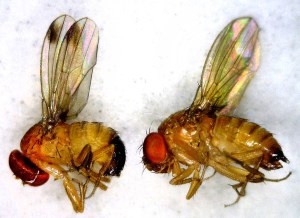It’s the bug to watch: Less than one-sixteenth of an inch long, the ladies fly around with serrated saws, the men with dots on their wings.
Last September the state caught the Spotted Wing Drosophila here for the first time, by the half-dozens.
This summer, less than a year later, Monmouth traps bagged up to 3,000 a week.
The fruit fly newcomer would be an annoyance like its cousins if not for one major difference, according to experts: The Spotted Wing Drosophila cuts a small hole in ripening fruit to lay eggs. The fruit, to the naked eye, can look fine for another day or two.
“If this was just another fruit fly that only attacked rotten fruit, we’d say no big deal,” said David Handley, vegetable and small fruit specialist for the University of Maine Cooperative Extension, based at Highmoor Farm in Monmouth.
“Because you’re picking fruit that looks perfectly sound and you put it on the kitchen shelf and the next morning you come out there’s maggots swimming in a soup, you’re going to be an unhappy customer and you’re not going to go visit that grower again,” Handley said.
For blueberry growers, its arrival could be particularly worrisome. Growers are used to spraying crops up to two times a season, but keeping the Spotted Wing Drosophila at bay could mean spraying twice a week.
“This could have huge impacts on the wild blueberry industry,” Handley said. “This is a game-changer.”
He’s part of a team that received a $50,000 federal grant to study the fly next year.
At a recent regional meeting of small fruit experts in New York, “this was the hot topic,” said Eric Sideman, crop specialist for the Maine Organic Farmers and Gardeners Association. “Everyone is applying for money for grants to do research on this topic. Extension people are out visiting farms all over to assess the damage and get a handle on what kind of damage there is. It’s so new.”
The fruit fly, native to northern Asia, was first spotted in California in 2008, according to Jim Dill, a UMaine Cooperative Extension pest management specialist and professor of biological sciences.
Last year in the wake of Hurricane Irene, Dill set traps around raspberry fields, red cups with apple cider vinegar and apple juice and yeast concoctions.
“A lot of times, things come in after hurricanes,” he said.
Dill found Spotted Wing Drosophila in small numbers at four Maine locations. This year, he started trapping around strawberries in June. The flies didn’t bother that crop. Numbers didn’t start to grow, and grow, until late July.
“We’re assuming the winter does knock the population back and it takes a while to build up, so the late-season small fruit crops are the ones that are of concern: blueberries, fall raspberries, blackberries,” Dill said.
Add chokecherries, elderberries, peaches and grapes to that list. The flies don’t appear to bother cranberries, apples or bananas.
The female Spotted Wing Drosophila has a serrated egg-depositor that saws into soft-skinned, ripening fruit. It can lay 300 eggs during its 14-day lifespan.
“You can see how the population would explode,” Handley said. “In each of those eggs there’s a little white maggot in one of your berries, and they don’t stop there.”
One very early estimate from the wild blueberry industry: The flies could affect up to 20 percent of the crop, he said.
The extension plans to survey farmers in early October for a more accurate damage count. Blueberries in Maine are a multimillion-dollar industry. It’s too early to know the impact to growers and prices.
“Raspberries are a fairly expensive fruit, anyway,” Dill said. “Now, if you’re spraying twice a week it might double the cost of them.”
He’s heard growers say they plan to hang it up.
Sprays exist for both traditional and organic farmers but brands have to be rotated with care; the fly can quickly develop resistance.
Dill said that he’s found Spotted Wing Drosophila this year everywhere he has set traps. The next year will be spent on research: Do some sprays work better than others? Could small netting work? Should growers harvest earlier? Is there a parasite that might develop a taste for the fly?
“As a grower, do you really want your income stream to stop at the end of July?” Handley said. “It’s pretty hard to make it as a farmer that way, unless you’re growing things that this thing won’t take an interest in.”
He added, “We don’t have a good answer for this one yet. We’re kind of in the position, unless you’re willing to let the crop go, you’ve got to protect it. Hopefully, research will send us down a road where we can find a good answer, but it’s pretty dark at the end of the tunnel right now.”
Dill’s best advice for consumers: Refrigerate your produce.
Traps can be made at home, he said, with a soda bottle, a piece of paper rolled up as if to create a funnel, a little apple cider vinegar and a few drops of detergent.

Comments are no longer available on this story